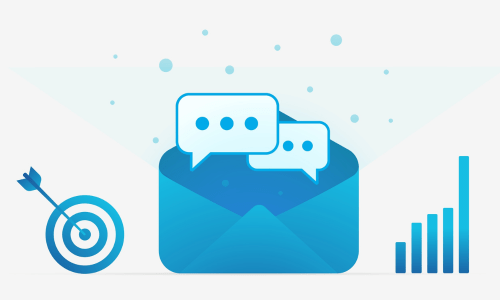B2B lead nurturing isn’t just a strategy—it’s a cornerstone for long-term business growth. Unlike B2C where impulsive buying is more common, B2B purchasing decisions are often complex and drawn out. Hence, nurturing leads through a tailored, step-by-step process is paramount for converting interest into sales.
In this insightful article, we’ll unlock the power of email as a nurturing tool. From dissecting why emails still reign supreme in the digital age to breaking down the elements of effective nurturing emails, we’ve got you covered. Whether you’re a novice or a seasoned marketer, you’ll find valuable nuggets that will help you craft the perfect email campaigns for B2B lead nurturing.
Why Emails are Still King
In an age where new digital platforms emerge seemingly overnight, it’s easy to overlook the staying power of email. Yet, emails continue to reign as one of the most effective tools in B2B marketing arsenals. According to HubSpot, email generates $38 for every $1 spent, boasting an astounding 3,800% ROI. These figures aren’t just numbers; they underscore the indispensability of email in any robust B2B lead nurturing strategy.
However, it’s not just about ROI; it’s about building relationships. Emails offer a direct and personal line of communication between businesses, allowing for targeted messaging that can be refined and personalized over time. This capacity for fine-grained customization makes email an invaluable tool for nurturing leads through the lengthy and often convoluted B2B sales funnel.

Components of an Effective Nurturing Email
When crafting a B2B nurturing email, it’s not just about what you say, but how you say it. Every element should be meticulously chosen to guide your lead further down the funnel. From subject lines that compel opens to CTAs that convert, each component plays a pivotal role.
- Subject Line: This is your first impression. Make it intriguing yet concise to improve open rates.
- Personalization: Utilize lead data to personalize greetings and content. Tailored experiences yield higher engagement.
- Value Proposition: Clearly articulate what you offer and why it’s beneficial. This is your hook.
- Content Body: Keep it succinct. Utilize bullet points, subheaders, and short paragraphs for readability.
- Call-to-Action (CTA): This should be clear and compelling, directing the lead to the next step you want them to take.
- Visuals: Incorporate relevant images or infographics to break up text and enhance understanding.
- Footer: Include mandatory elements like an unsubscribe link and your physical business address to adhere to email regulations.
Types of Nurturing Emails
In B2B lead nurturing, one size doesn’t fit all. Different stages of the buyer’s journey demand varying types of emails. Initially, you’ll want to focus on education-based emails to build trust and establish expertise. These emails often take the form of newsletters, how-to guides, and curated content roundups that offer value without pushing for a sale.
As the lead progresses, switch gears to more targeted and persuasive emails. These include product demos, testimonials, and case studies that showcase the tangible benefits of your offerings. The goal is to provide enough compelling evidence for leads to make an informed decision, transforming from a nurtured lead to a paying customer. Tailoring your email type to the buyer’s journey not only enhances user experience but also improves conversion rates.

Welcome Emails
The first email is the virtual handshake that sets the stage for all future communications. A well-crafted welcome email serves as an introduction, solidifies trust, and provides immediate value, all while encouraging the lead to engage further with your brand. It’s your chance to make a strong first impression and lay the foundation for a meaningful business relationship.
- Personalize: Use the lead’s name and refer to how they found you, if possible.
- Set Expectations: Briefly outline what type of content they can expect to receive and how often.
- Provide Value: Include a link to a valuable resource or offer a special introductory promotion.
- Encourage Action: Include a clear call to action (CTA) to guide leads to the next step, whether it’s following you on social media or reading a particular blog post.
Follow-Up Emails
After the initial engagement, the follow-up email serves as a crucial touchpoint to maintain interest and guide the lead through the sales funnel. Depending on the context—be it a downloaded resource, an uncompleted transaction, or simply a week’s worth of inactivity—a properly timed and formulated follow-up can propel the lead to the next stage of the buyer’s journey.
- Contextual Trigger: Tailor the email content to what triggered the follow-up in the first place.
- Time-Sensitive: Send the email when it’s most relevant. For example, a follow-up to an abandoned cart should ideally be sent within 24-48 hours.
- Soft Sell: Use a gentle approach, focusing on benefits and value rather than aggressive sales language.
- Clear CTA: Provide a straightforward next step, like finalizing a purchase, scheduling a consultation, or downloading another resource.
Re-Engagement Emails
When a lead goes cold, it’s not the end of the road; it’s an opportunity for a re-engagement email to reignite interest. A well-crafted re-engagement email can remind leads of the value your business provides and encourage them to pick up where they left off, becoming active once again in your sales cycle.
- Personalized Content: Tailor the message to reflect the lead’s previous interactions with your brand, making it more relevant and engaging.
- Exclusive Offers: Entice them back with a special offer or discount, creating a sense of urgency and value.
- Feedback Request: Sometimes leads go cold for a reason; asking for feedback can offer insights and demonstrate that you value their opinion.
- Clear CTA: Make it easy for them to re-engage by offering multiple avenues—be it a ‘Learn More’ link, a direct line to a sales representative, or an exclusive downloadable resource.
Additional Advice
Crafting the perfect B2B lead nurturing email campaign is not a task to be taken lightly. From understanding why emails continue to dominate the digital landscape to dissecting the essential components of a high-converting email, the methodology behind effective lead nurturing is as calculated as it is creative. With different types of emails like welcome, follow-up, and re-engagement, you have various tools at your disposal to guide your leads through the buyer’s journey.
As we’ve outlined, the art of email lead nurturing lies in the details. From segmentation and personalization to timing and content relevance, every element must be meticulously planned and executed. It’s this marriage of strategic thinking and tailored communication that turns a cold lead into a loyal customer. Mastering this art form is not just a nice-to-have; it’s a business imperative.
Take Your Email Campaigns to the Next Level with CyberTheory
Feeling overwhelmed? Don’t worry, you don’t have to go it alone. If you’re looking to build or refine your email lead nurturing campaigns, our team at CyberTheory can provide tailored solutions that resonate with your audience. From strategy formulation to content creation, we’ve got you covered. Click here to kickstart your journey toward better B2B lead nurturing.